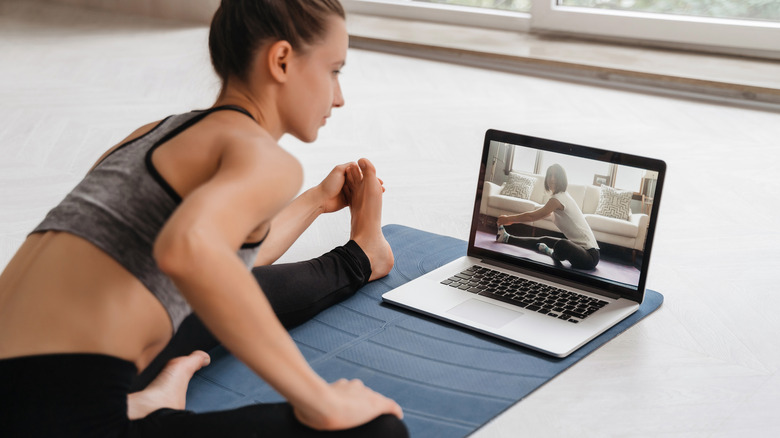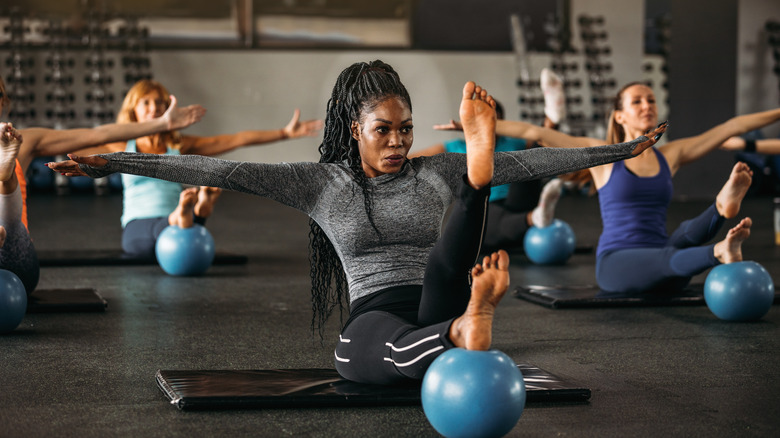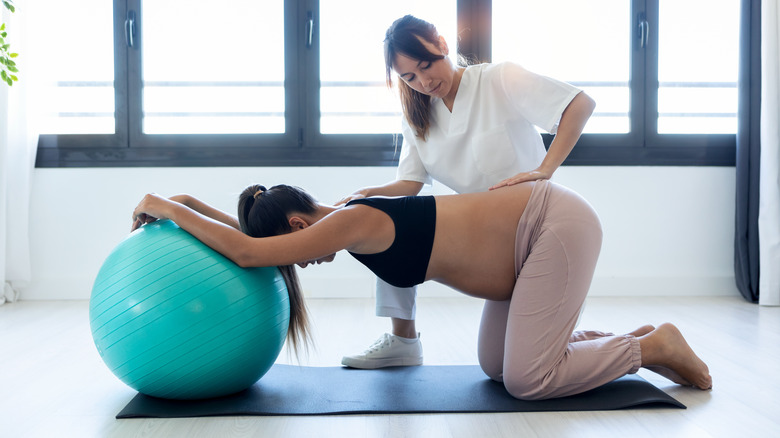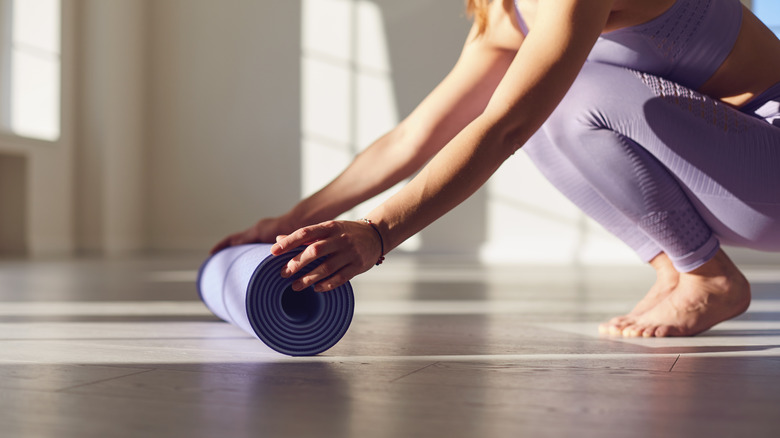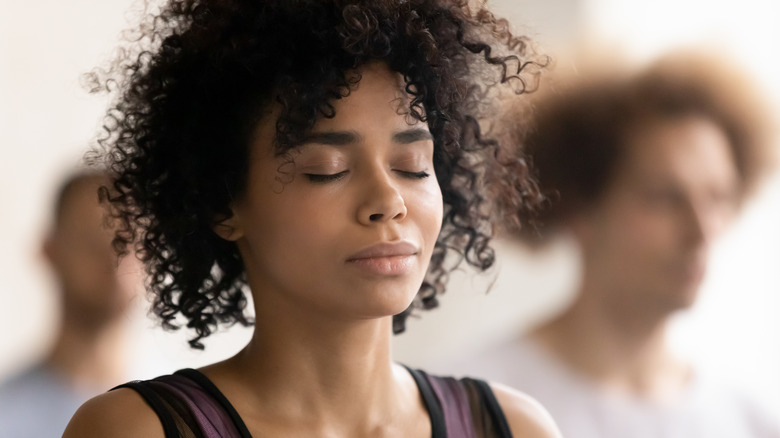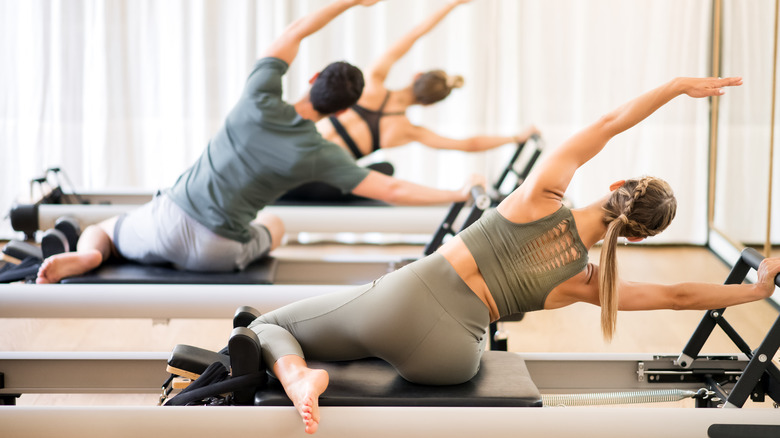How To Get Started With Pilates — At Home Or At The Studio
When Joseph Pilates started to develop his eponymous exercise program at the height of World War I, it was to help his fellow prisoners at internment camp remain physically fit and recover from their injuries. Using whatever was available inside the camp, such as bed springs, he taught the other detainees how to use resistance while doing repetitive movements to build their bodies' strength and mobility.
The ingenious spirit behind Pilates' development has made this form of exercise something anyone can practice even within a cozy, confined space. No wonder it became one of the most popular online fitness classes at the height of the pandemic. Good Times Pilates founder Cat Webb told Body and Soul, "Being shut inside for most of 2020 meant we had to find new ways to work out that involved minimal equipment, coupled with styles of fitness that were generally accessible and easy to follow with just a mat and a screen." Now, with studios open again, recent converts are finding more to explore in classes that offer Pilates equipment. From the bed springs and beer keg rings during Joseph Pilates' time, there are now Pilates reformers, stability balls, resistance bands, and more.
If you're a total newbie who wants to try out Pilates, you might have seen videos of instructors and influencers doing slow, graceful, and repetitive movements and thought, "Those don't look difficult." Don't be fooled, though. In fitness, sometimes the simplest-looking moves require (and develop) the most muscle strength and control.
Pilates may be slow and graceful but it's not easy
According to certified instructor Lencola Green, Pilates has six principles: centering, concentration, control, precision, breath, and flow. These, she explained to Self, give its movements the "slow, refined, and deliberate" quality they're known for. No matter the student, whether they're a novice or a long-time practitioner, a qualified instructor focuses on helping them get their form correct first to execute a movement. Breathwork is also crucial. "The rhythm and depth of your breath can greatly influence the effectiveness of each exercise, making it an essential aspect of your overall experience," Pilates Reformers Plus explained. It helps you become more in tune with your body and zero in on what adjustments you need to make to maintain proper form and control despite multiple repetitions of each movement.
Although more dynamic routines like high-intensity interval training (HIIT) can burn up a ton of calories and improve one's cardiovascular fitness, lower-impact Pilates is a great fitness alternative, especially for those who have joint issues. In fact, a study confirmed its rehabilitative function when done properly. It's also effective for cross-training, according to Campbell Clinic, with runners, dancers, and athletes using it to improve their balance, flexibility, and mobility, and strengthen muscles to avoid injuries. Cleveland Clinic also classifies Pilates as a form of strength training that tones up the muscles to increase their endurance rather than increase their mass.
Finding a good instructor is key
Whether you plan on doing Pilates at home or attending a studio class, a capable instructor is the first step to take. The Hospital for Special Surgery (HSS) suggested checking the professional organization Pilates Method Alliance's website, which lists its members who are certified instructors. You can also ask for recommendations from friends or acquaintances and check online forums for local or nearby Pilates communities. Once you've found a viable candidate, HSS advised respectfully asking them questions about their training, experience, and certification, the clientele they usually service, and their other qualifications to be Pilates instructors.
Once you're ready to try out a Pilates teacher, be open with them about any injuries or mobility issues you might have. A good instructor knows how to listen to a student's concerns about their physical condition and accommodate their limitations, even when it's in a class setting. They should be able to offer modifications to specific movements so all attendees can get in their workout without sacrificing safety.
Get a good, non-slip Pilates mat
Plenty of videos online feature Pilates classes that use a variety of equipment to support the body and engage different muscle groups. If you're a complete beginner, don't feel pressured to buy all of them at once. Invest instead in a quality Pilates mat. Marie Claire differentiated this from the usual yoga mat as around half an inch thicker and denser, providing more support during floor work. Of course, there's nothing wrong with using a yoga mat you might already have, but be mindful about having additional cushioning ready, such as a towel or blanket, so your joints don't feel too much pressure while doing certain poses and movements. For example, when you need to be on your hands and knees, roll up the mat a bit so your knees have a gentler surface to rest on.
Later on, once you've gotten the hang of it, you can build your collection of Pilates props: resistance bands, stability and mini-balls, a magic circle ring, and small weights. (You can also use similar-sized water bottles and canned goods as cost-effective substitutes for weights.) You might also want to try out a class that uses the Pilates reformer as a leveled-up challenge.
Master breathwork and the fundamental poses first
The promise of longer, leaner, and stronger muscles may tempt you to go all out in your first class, but to avoid overextending yourself and possibly getting injured, start with getting the basics right. Ideally, your first Pilates class should be held in person with an instructor so they can really guide you through the whole session, and explain clearly the corrections you need to make. In case you're doing it online, listen and be open to your teacher's notes on your form then apply them as best as you can.
Don't be embarrassed if you feel as if you can't execute even the simplest movement right. Healthline advised mastering your awareness and using your breath first since, according to the website, "it's the foundation of every exercise." By inhaling and exhaling properly, you learn how to gather and release energy to pace yourself and engage the right muscle groups.
At the end of your class, it would be helpful to have a quick chat with your instructor to get some feedback and clarifications for any movement or pose that confused you. Building rapport with your Pilates teacher will make you feel supported in your fitness journey and you'll be able to track your progress through the eyes of a professional. It would also be great to join your local Pilates community so you have peers who can cheer you on while also holding you accountable for your practice and vice-versa.
Be consistent with your budding Pilates practice
As we've mentioned, Pilates may look simple and easy but it's no walk in the park. You need to keep at it to experience its benefits. To build your practice and make it a habit, deliberately make space for it in your schedule. Whether you do Pilates at home or in a studio, it helps that you set a consistent time and day for it so you train yourself to mentally prepare for class. Per Healthline, a thrice-a-week practice is ideal. You can gradually ramp up to a more frequent schedule as you begin to feel stronger and more confident but do listen to your body on days when you feel weak or sick.
While there's limited evidence on Pilates' capacity to improve women's health pertaining to certain conditions such as breast cancer, obesity, or low back pain, a 2020 study discovered that healthy adult women can improve their functional capacity with just two months of equipment-based Pilates training; imagine sticking to it for a much longer period. Whenever you start to feel wiped out by Pilates' difficulty, remind yourself of your goal: You're exercising to invest in your health and improve the quality of your life.
